I KNOW, as a plant OWNER, seeing your beloved plant leaves turning yellow can be DISHEARTENING.
Don’t WORRY!
We have GOT you covered.
Providing you with a COMPREHENSIVE GUIDE on caring for your orchids. And ensuring HEALTHY and VIBRANT plants in your home or garden.
We are going to GUIDE you with the EXPERT TIPS you need to IDENTIFY the cause of orchid’s yellowing leaves.
Thus, you TRUST US to provide the INFORMATION you need for the MAINTENANCE of your plant leaves and FLOWERS.
With our HELP, gain clarity and see how EASY it is to save your orchid plant.
This post EQUIPS you with the information you NEED to care for your orchids and keep them THRIVING.
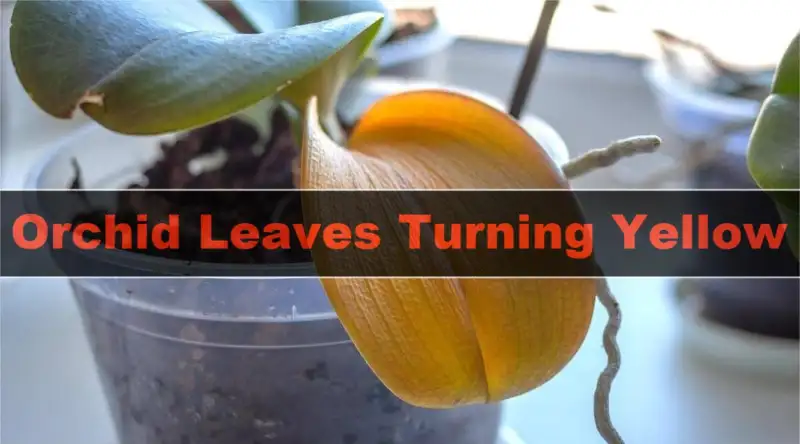
What are the Symptoms of Yellowing Orchid Leaves?
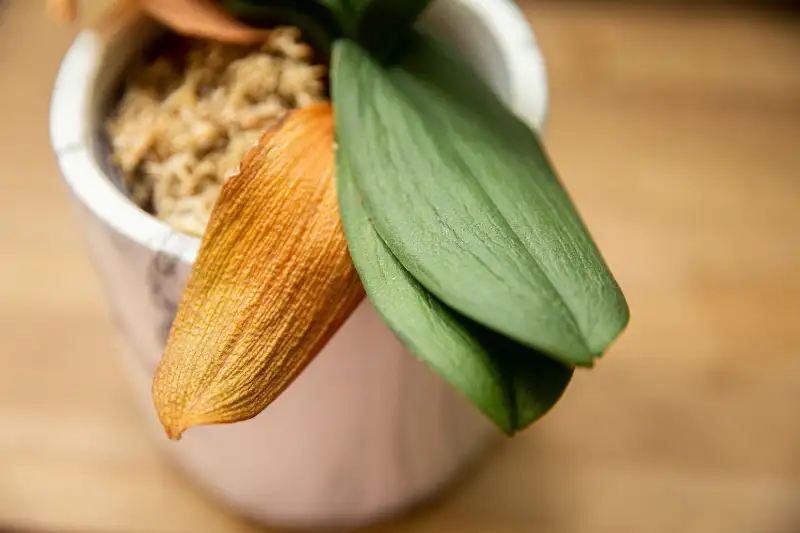
Yellowing orchid leaves can be a sign of STRESS or DAMAGE to your particular plant.
The SYMPTOMS of yellowing leaves in the orchid plant can vary DEPENDING on the cause.
Some COMMON symptoms of yellowing leaves include,
Bright Yellow Leaves
The house plants can get BURNT leaf tips if exposed to too much DIRECT sun for a long time.
It can cause the leaves to turn bright yellow and even brown or black.
As direct sunlight causes burns to the plant. Too little light will inhibit the plant from flowering.
So which type of light orchids prefer?
WELL! Orchids PREFER bright, indirect sunlight.
Therefore, I choose to place my orchid in a SHADIER SPOT or behind a sheer curtain to FILTER the light.
Uniform Yellowing
If the yellowing of leaves is UNIFORM across the ENTIRE plant or a specific part of the plant. It may be an indication of nutrient deficiencies or overwatering.
Getting my point?
DEFICIENCY of nutrients occurs when the plant is NOT GETTING enough nutrients like
- Nitrogen
- Iron
- Magnesium
While overwatering can cause root rot. Thus preventing the plant’s roots from absorbing enough nutrients.
Spotty Yellowing
Suppose yellowing OCCURS with a bacterial brown spot or fungal leaf spot. It is probably a sign of bacterial or fungal infection.
COMMON fungal infections of the orchid plant include:
- Cercospora
- Black rot
These infections are CAUSED by overwatering and poor humidity.
So DON’T ALLOW your orchid to sit in water, and TRY to provide it with GOOD air circulation.
Causes for Orchid Leaves Turning Yellow
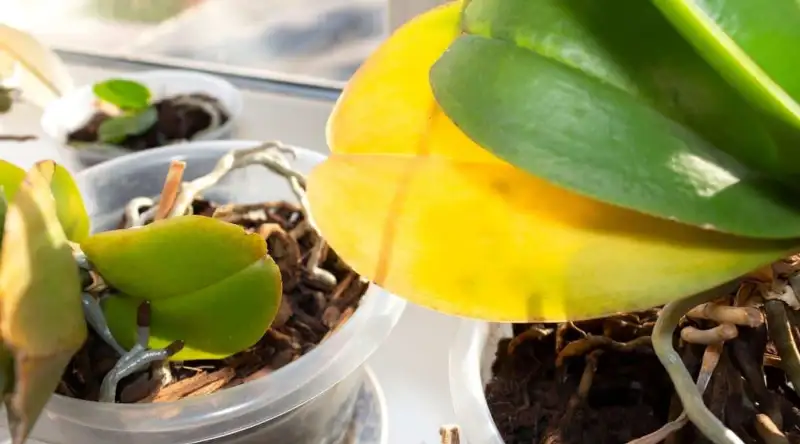
Orchids are POPULAR indoor and outdoor houseplants known for their STRIKING BEAUTY.
However, like other plants, orchids can SUFFER from various problems.
The MOST COMMON of all the problems is the orchid leaves TURNED YELLOW. These yellow leaves of your orchid INDICATE a RANGE of issues.
THEREFORE, it is essential to IDENTIFY the cause to prevent further damage to the plant’s health.
Some COMMON CAUSES for orchid leave turning yellow include,
Watering Problems
If the leaves are wrinkled or inactive, there are many chances that your orchid is DEHYDRATED.
If only LEAVES are yellowing, you may have OVERWATERED your plant.
The MAIN REASON why orchid leaves turning yellow is that they are being overwatered.
It means:
- They are being watered TOO FREQUENTLY, or
- They are in a container that DOESN’T PERMIT for adequate drainage.
Get this?
I RECOMMEND you check the orchid roots if you THINK overwatering is the problem.
It is because overwatering can LEAD to root rot, which TRIGGERS the leaves to turn yellow.
Temperature Stress
Ask YOURSELF whether the temperature is right.
Orchids tolerate temperatures between 60 and 80ºF.
So, ENSURE that the temperature stays within the normal range.
If your plant is SUBJECTED to more or less temperature, it falls VICTIM to EXCESSIVE stress.
And what are the SYMPTOMS of temperature stress?
- You MIGHT NOTICE the leaf yellowing, as well as the orchid leaf drop.
- Temperature stress can also cause the browning or blackening of leaves.
Too Much or Too Little Light
Yellowing leaves in response to light is TRICKY because it is caused by BOTH little and much sunlight.
The leaves of the orchid plant can BURN or turn yellow if SUBJECT to too much direct sunlight.
Mostly the DELICATE orchids need entirely bright, indirect light.
- Without sufficient light, the plant is UNABLE to produce chlorophyll through PHOTOSYNTHESIS. It results in TURNING the leaves yellow.
- Inadequate light also INHIBITS the formation of buds so that flowers will be SCARCE.
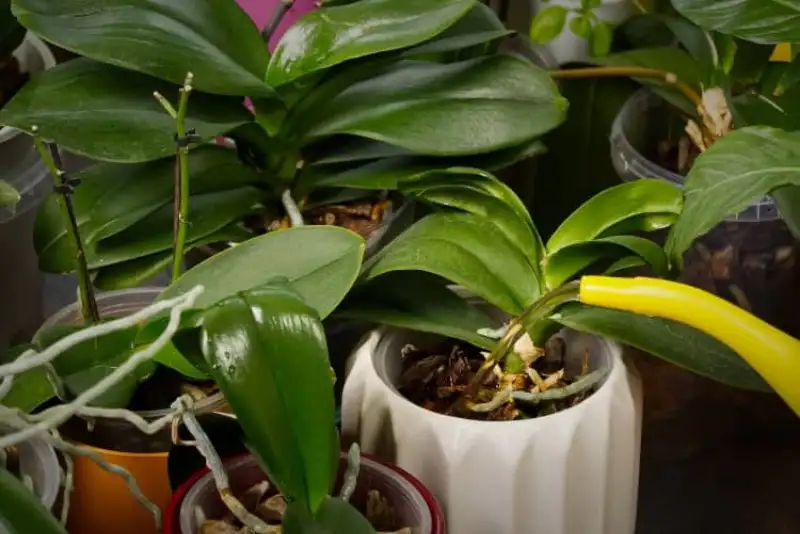
Not Enough Humidity
Orchids are native to tropical and subtropical climates that require humidity to THRIVE.
When the humidity in the air DROPS below their IDEAL LEVEL, it LEADS the leaves to turn yellow.
I THINK low humidity can be CAUSED by a NUMBER OF FACTORS, including:
- Dry air from heating or air-conditioning systems
- Insufficient MOISTURE in the soil
- Inadequate watering
Nutrient Deficiencies
Orchids aren’t HEAVY FEEDERS. They still require a CONSISTENT supply of nutrients to keep their leaves lush and green.
If you don’t GIVE orchid specific fertilizer, the nutrient deficiency cause yellowing.
But which nutrients are lacking in plants?
If the healthy orchid leaves INITIATE to turn yellow around the EDGES and the SIDES, your plant is likely low in,
- Nitrogen
- Magnesium
- Iron
- Zinc
Natural Aging
Last but not least.
It is also POSSIBLE that there isn’t any problem with your plant.
Orchid leaves NATURALLY turn yellow as they age and die off. A mature orchid naturally loses about two leaves per year.
So, if the yellowing is LIMITED to lower leaves, it could INDICATE normal aging.
Still, if the leaves are yellowing from the TOP of the plant, there MUST be a PROBLEM.
Solutions for Orchid Leaves Turning Yellow
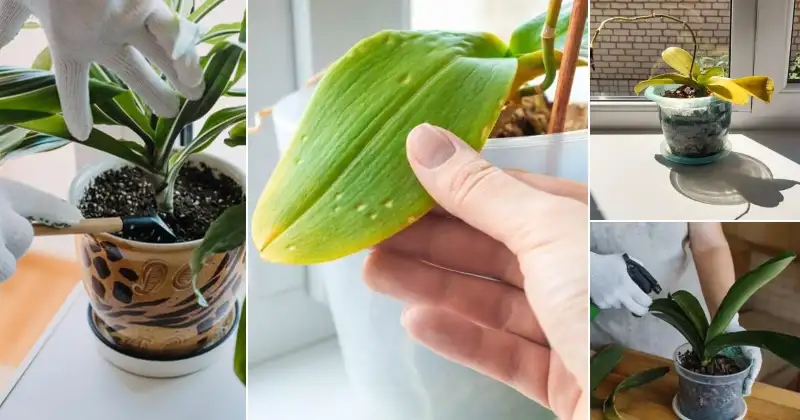
When an entire leaf turns yellow, it may be a SIGN of an issue that really needs ADDRESSING.
Depending on the cause, there are different SOLUTIONS to RESTORE the plant’s health.
Let’s discuss the solutions to all the GIVEN problems ONE BY ONE.
Watering Problems
Adjust the WATERING ROUTINE.
Ensure that the plant receives ADEQUATE water to prevent dehydration. Water the plant thoroughly, but AVOID too much moisture to the plant.
What if you have already overwater your orchid?
- Save overwatered orchids by removing and trimming away any black and DEAD roots. Doing so helps to ensure healthy green roots.
- Water the plant only when the top one inch of the new orchid potting mix is DRY.
- Make sure that there are DRAINAGE HOLES in the pot to ALLOW proper drainage.
- To avoid overwatering, use three ice cubes once weekly so that healthy roots SOAK UP water slowly.
Temperature
The EFFICIENT way to prevent temperature stress is to KEEP their environment RELIABLE.
But how can you do so?
I usually use a thermometer in this regard.
- Using a thermometer, CHECK whether your SELECTED location is within the acceptable range.
- Avoid placing your orchid near OPEN windows and air conditioner vents. It is because these DRY OUT your orchid QUICKLY.
Light Issues
Although orchids LOVE LIGHT, they still don’t like STAYING in too much direct sunlight.
As I mentioned earlier, orchids prefer bright, indirect sun to GROW happy and healthy.
- If your plant isn’t GETTING enough sunlight, you must RELOCATE the plant to a sunnier location.
- Contrarily, if your orchid is CLOSE to a window, move it a few feet back.
- If it is in the LINE of DIRECT sunlight, REPOSITION the plant to a place where it gets bright, indirect light is good.
- ANOTHER OPTION that I use is to HANG a sheer curtain between the window and the plant.
Humidity
You can USE humidity trays to keep your orchid properly hydrated. So it can BASK in the MOIST AIR as the water EVAPORATES from the tray.
When a humidity tray isn’t enough, it is SUGGESTIBLE to INVEST in a humidifier.
Nutrients Deficiency
The nutrient DEFICIENCY can easily be FULFILLED.
You just need to start APPLYING the orchid fertilizer every other week. Or according to the INDICATIONS mentioned on the fertilizer.
Natural Aging
If only the OLDEST leaves are turning yellow, it is a natural process. So, just LET NATURE run its COURSE.
When those leaves have fulfilled their PURPOSE for the plant, they will FALL OFF on their OWN.
Thus I don’t RECOMMEND you prune off the old leaves.
Care Tips for Orchid Plants
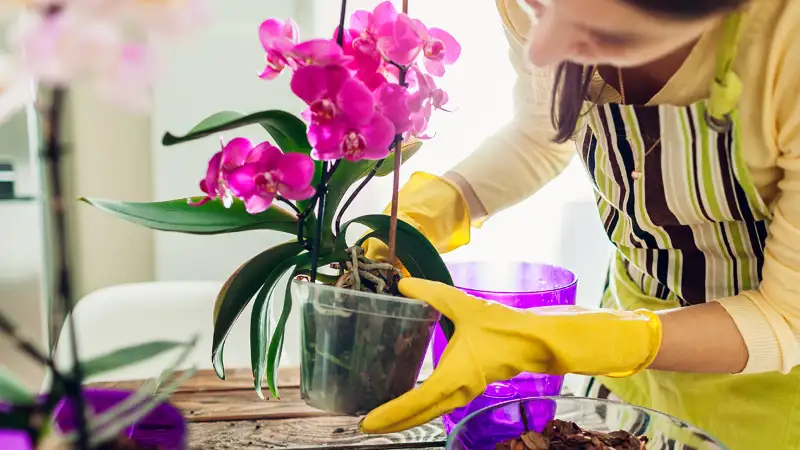
Orchids are BEAUTIFUL plants that require SPECIFIC care to thrive.
Let’s discuss some TIPS to care for orchids:
Choose the Right Pot
LISTEN! Orchids neither like TOO MUCH sunlight nor TOO LITTLE light.
Direct sunlight can DRY them out quickly, while little light STOP the plant’s flowering.
Thus, CHOOSE the spot where it gets bright, indirect sunlight.
You can place it near a window that gets morning sun or use artificial light if natural one isn’t sufficient.
Watering
Orchids need to be watered CONSISTENTLY. Still, they don’t like to be overwatered.
Therefore, I only PREFER watering the orchid when the potting medium is nearly dry.
Watering once a week is AWESOME. But the FREQUENCY depends on its type, size, and the environment in which it is growing.
Potting Mix
Orchids REQUIRE a well-drained fresh potting mix. It ALLOWS the air to CIRCULATE around the roots.
A good ordinary potting soil for orchids is a mixture of,
- Bark
- Sphagnum moss
- Perlite
Fertilizer
Like other plants, orchids require SUFFICIENT fertilizers to GROW WELL. A balanced fertilizer can be USED once a month during the growing season.
NOTE: Avoid fertilizing an orchid when it is not actively growing.
Repotting
Orchids require to be REPOTTED every one to two years.
So it is BETTER to repot your plant in an aerated potting medium and a SLIGHTLY LARGER pot than the previous one.
FAQs about Orchid Leaves Turning Yellow
1. Should you remove yellow leaves from orchids?
Generally, I don’t RECOMMEND you cut yellow orchid leaves.
Instead, ALLOWING the yellow leaf on orchid plants to off naturally is best.
But if there is clear EVIDENCE of diseases, it is crucial to REMOVE the affected area.
2. What do overwatered orchids look like?
Overwatered orchids develop a VARIETY of symptoms that can EASILY be spotted.
These include,
· The leaves turn yellow and feel MUSHY or soft to the TOUCH.
· The potting mix has a FOUL ODOR.
· Slow or minimal new leaf growth.
· Roots also turn brown or black and become mushy.
3. Will an orchid come back after overwatering?
Ah! Yes, an orchid can come back after overwatering. But only if the PROBLEM is caught early and CORRECTIVE ACTION action is taken.
On the other hand, if the plant is LEFT sitting in water for too long, it can DEVELOP root rot. Root rot is a SERIOUS CONDITION that can be difficult to treat.
If the roots have ALREADY started to rot, cut away the AFFECTED part and repot the plant.
4. Are used tea bags good for orchids?
Used tea bags contain tannins and micronutrients that can aid plant growth.
The tannins in tea can help LOWER the soil’s pH, which is BENEFICIAL for some orchid species.
It is ESSENTIAL to use tea bags in MODERATION. Excess use can lead to the BUILDUP of organic matter and excess moisture.
What’s Next
Hope so! You NO LONGER need to be ALARMED about the yellow leaves of the orchid plant.
There are DIFFERENT REASONS why your orchid leaves turning yellow. So INSTEAD of worrying about it, IDENTIFY the cause and take PROPER CARE to revive your plant.
That’s all for today.
If you are willing to LEARN more about plants, don’t FORGET to visit AsterGardening.
Here you will get QUALITY TECHNIQUES for the maintenance of your plants. So, if you have any PROBLEM, reach out to us.
